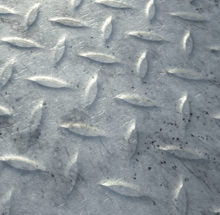Physically based rendering


Physically based rendering or PBR is a shading model in computer graphics that seeks to render graphics in a way that more accurately models the flow of light in the real world. Many PBR pipelines (though not all) have the accurate simulation of photorealism as their goal, often in real time computing.
History
Starting in the 1980s, a number of rendering researchers worked on establishing a solid theoretical basis for rendering, including physical correctness. Much of this work was done at the Cornell University Program of Computer Graphics; a 1997 paper from that lab[1] describes the work done at Cornell in this area to that point.
The phrase was more widely popularized by Matt Pharr, Greg Humphreys, and Pat Hanrahan in their book of the same name from 2004, a seminal work in modern computer graphics that won its authors a Technical Achievement Academy Award for special effects.[2]
Process
As described by researcher Jeff Russell of Marmoset, a physically based rendering pipeline will focus on the following areas:[3]
- Reflection
- Diffusion
- Translucency and transparency
- Conservation of energy
- Metallicity
- Fresnel reflectivity
- Microsurface scattering
PBR is, as Joe Wilson puts it, "more of a concept than a strict set of rules"[4] – but the concept contains several distinctive points of note. One of these is that – unlike many previous models that sought to differentiate surfaces between non-reflective and reflective – PBR recognizes that, in the real world, as John Hable puts it, "everything is shiny".[5] Even "flat" or "matte" surfaces in the real world such as rubber will reflect a small degree of light, and many metals and liquids will reflect a great deal of it. Another thing that PBR models attempt to do is to integrate measurements from photographs of real-world materials regarding constants or models to simulate albedo, gloss, reflectivity, and so on. Finally, PBR puts a great deal of emphasis on microsurfaces, and will often contain additional textures and mathematical models intended to model small-scale specular highlights and cavities resulting from smoothness or roughness in addition to traditional specular or reflectivity maps.
Application
Thanks to high performance and low costs of modern hardware[6] it has become feasible to use PBR not only for industrial but also entertainment purposes wherever photorealistic images are desired including video games and movie making[7]. Since consumer-grade mobile devices such as smartphones are capable of running VR content in real-time, PBR has created a market for easy-to-use programmes for free that define and render content in real-time where sacrifices in visual fidelity are acceptable[8]:
State of the art
A typical application provides an intuitive graphical user interface that allows artists to define and layer materials with arbitrary properties and to assign them to a given 2D or 3D object to recreate the appearance of any synthetic or organic material. Environments can be defined with procedural shaders or textures as well as procedural geometry or meshes or pointclouds[9]. If possible all changes are made visible in real-time and therefore allow for quick iterations. Sophisticated applications allow savvy users to write custom shaders in a shading language.
References
- ↑ Greenberg, Donald P., Torrance, Kenneth E., Shirley, Peter, Arvo, James, Ferwerda, James A., Pattanaik, Suumanta, Lafortune, Eric, Walter, Bruce, Foo, Sing-Choong, and Trumbore, Ben "A Framework for Realistic Image Synthesis". Retrieved on 27 November 2017.
- ↑ Pharr, Matt, Humphreys, Greg, and Hanrahan, Pat. "Physically Based Rendering". Retrieved on 14 November 2016.
- ↑ Russell, Jeff, "PBR Theory". Retrieved on 14 November 2016.
- ↑ Wilson, Joe. "Physically Based Rendering – And You Can Too!" Retrieved on 12 Jan 2017.
- ↑ Hable, John . "Everything Is Shiny". Retrieved on 14 November 2016.
- ↑ Kam, Ken. "How Moore's Law Now Favors Nvidia Over Intel". Forbes. Retrieved 2018-05-29.
- ↑ "Physically Based Rendering: From Theory to Implementation". www.pbrt.org. Retrieved 2018-05-29.
- ↑ "Physically Based Shading on Moblie". Unreal Engine. Retrieved 2018-05-29.
- ↑ "Point Clouds". Sketchfab Help Center. Retrieved 2018-05-29.